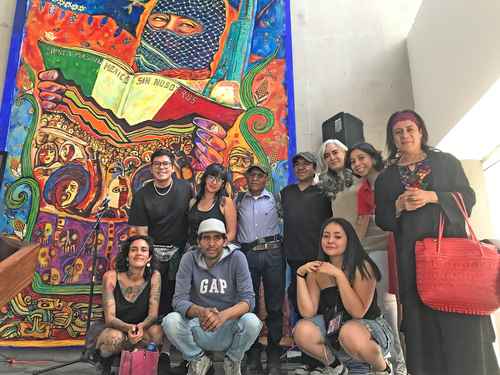
In the image, the community leader of San Salvador Atenco, Ignacio del Valle (blue shirt), along with Guchepe (in black), surrounded by the participants in the conclusion of the mural.
It was created with the conviction of ‘’continuing to sow consciousness through art and culture’’: Guchepe
At noon yesterday, a Zapatista mural for Tlatelolco was inaugurated at the Tlatelolco University Cultural Center, created with the conviction of continuing to sow in consciences, through art and our participatory culture, said the author of the mural, Gustavo Chávez Pavón, Guchepe.
The muralist explained to La Jornada: in organizations we reinforce awareness and continue sowing libertarian seeds. This is really cool. He said he was very moved by the support of Ignacio del Valle, community leader of San Salvador Atenco, which is an endorsement of the commitment we continue to have.
The colorful large-format painting includes motifs of social struggle, with figures such as Emiliano Zapata, a machete and a mass of people, as well as indigenous symbols of America, for example, the wiphala flag of the Andean peoples. The legend says: ‘’Never again will there be a Mexico without us.’’
Ignacio del Valle, leader of the People’s Front in Defense of the Land and imprisoned in the context of his opposition to the New International Airport of Mexico City, recalled that Gustavo Chávez came to that movement against the dispossession of the land more than 15 years ago and made it possible for people to paint and participate in many murals that were made in the streets and in the community.
Regarding the installation of this mural, he mentioned: “it is a very important step and that form of reflection that we do with our gaze on these walls gives us a lot of encouragement.’’
‘’It refreshes us and makes us know that we have a very important identity of which we should feel completely proud: the dreams of our grandparents that commit us to the journey and the change that we need in our communities and in our towns.’’
Pavón said that he started the mural at home and then other people participated for two days, “a little example of how it is done in a community way with compañeros from Atenco, Chiapas and many other places, where we have been able to participate more days on a work or making banners for the marches.’’
“We got an idea of what it is like to exercise the right to make art, because we have discovered that art is another language, one more of the heart, of the soul, and that is why it excites us, we share it and we cannot keep it or capitalize on it. We walked with our compañeros taking over streets, factories, creating autonomous territories with the Zapatistas, creating murals. That’s why it’s more emotional, because it comes from my heart, but the red-and-black heart.”
Guchepe reported that the work that commemorates the social struggle in Mexico and the world and for the 30 years of the Zapatista movement will be exhibited at the M68 Memorial and Social Movements on the university campus.
He concluded that he is not a painter nor does he aspire to be one, but he is a cultural worker who was born into that activity in social movements.
‘’I begin to really paint within that consciousness in the heat of the marches, of the red-and-black flags.’’
Original article by Reyes Martínez Torrijo in La Jornada April 4th, 2024.
Translated by Schools for Chiapas.
Photo: Reyes Martínez Torrijos
